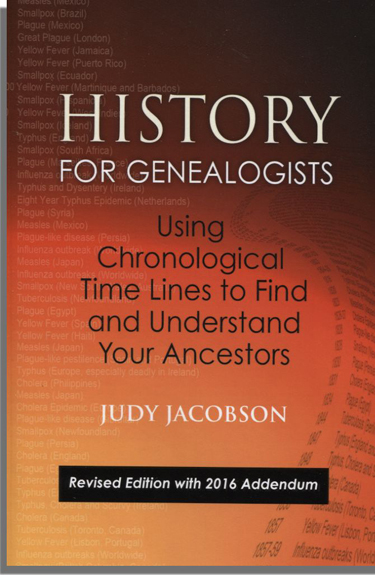As a fan of timelines for family history, I have a great appreciation for the many condensed historical timelines and background explanations included in Judy Jacobson's History for Genealogists, published by Genealogical.com and updated in 2016.
The subtitle of this book really says it all:
Using chronological time lines to find and understand your ancestors.
In ten chapters plus bibliography, index, and addendum covering the 20th century's two big wars and Great Depression, as well as a 20th century fashion and leisure timeline, Jacobson provides the building blocks needed to put our ancestors into historical and social context. And, as she ably points out, understanding chronology can help us locate elusive ancestors by suggesting where people might be at a certain point in history.
The index is excellent, more than 30 pages long. I found it particularly helpful for pinpointing pages with info and timelines on ethnic groups, immigration patterns, military conflicts, state-by-state settlement, Westward expansion, and many other specific topics. Interestingly, "Mayflower" was not an index entry but "Plymouth" and "Plymouth Colony" were both in the index. So do consider a variety of ways to describe your ancestor's past and investigate all of this terminology in the index.
Here is the jam-packed table of contents:
- Seeing Ancestors in Historical Context
- Creating a Time Line: Why? How? Case Studies
- Why Did They Leave? Military, foreign skirmishes, racism/injustice/unrest, politics, religion, disease, economics, disasters
- How Did They Go? By road, rail, water, air
- Coming to America (including historic migration patterns, traditional trails and roads)
- Myths, Confusions, Secrets, and Lies
- Even Harder to Find Missing Persons (including name changes, slaves, orphan trains, place-name changes, changing boundaries, more)
- Social History and Community Genealogy (immigration, industrial revolution, associations/unions, genealogy in books, oral histories)
- State by State Timelines (including Colonial times)
- Region by Region Timelines (North America and well beyond)
I highly recommend this book as a reference tool for understanding the sweep of family history and putting individual decisions into the context of local, regional, national, and international history.
Please note: I was given a free copy of this book for review purposes, but my opinions are entirely my own.











